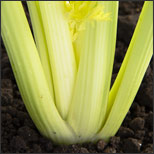Growing Celery Made Easy the Organic Way

Are you looking to tackle the “tricky to grow” celery?
This weekend’s weather forecast shows that it is going to be beautiful in most of the country. If you’re looking for a weekend project, we may just have one for you. Today, we are sharing some great tips on growing celery.
Celery can be a difficult vegetable to grow. This year, celery also moved into the number 2 spot on the dirty dozen. The dirty dozen is a list of fruit and vegetable that contain the most pesticides reported by the he EWG or The Environmental Working Group.
Now-a-days, there is a big push to eat clean and organic vegetables, however, organic can be pricy. One of the best ways to provide you and your family with organic fruits and vegetables is to grow them yourself. Celery is a tricky vegetable to the dismay of many gardeners.
Celery may be hard to grow but today, we are going share a few tricks that we’ve discovered that will help you to grow your own organic celery.
- The Old Farmer’s Almanac has a great tip to start us off with:
Celery seeds should always be started indoors for the best success rate, 8 to 10 weeks before the average last frost date for your area.”
- Celery is one of the plants that need the soil it grows in to remain moist. This can be difficult since celery is a summer plant in the north. We recommend that you install Rootsticks in your celery garden.
By installing Rootsticks you can control the moisture in the soil, solving the problem. The Rootstick is a direct to root watering system. When you notice the soil losing its moisture, simply pour water into the Rootsticks. Your celery plant will then receive the water, nutrients, and oxygen it needs to make it through summer.
- Our last tip comes from Organic Gardening. They recommend to:
Soak the tiny seeds overnight to encourage germination. Fill a container with a mix of * compost and * sand, and plant in rows 1 inch apart. Cover the seeds with a sand layer * inch deep, then cover the flats with damp sphagnum moss or burlap until seeds sprout.”
Enjoy your weekend, and please tell us about your weekend project plans.



